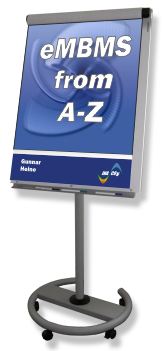 eMBMS from A-Z
eMBMS from A-Z
[2-day course, Euro 2,350.- (net) per participant]

Overview of Broadcasting Technologies
- Important broadcast technologies
- DVB (DVB-S, DVB-T/H), DMB, MBSAT, ATSC, MBMS
- History of MBMS and its Future
- Rel.6 MBMS and its Limitations, Evolution with Rel.9, Rel.10, Rel. 11 and outlook, why cellular broadcast (eMBMS) gains the attention of operators, Impact and possibilities with LTE-A and beyond.
- Some MBMS use cases and service categories
- text notification, video + audio + general content distribution, software download
- Comparison between MBMS and some other broadcast technologies
- indication of operator advantages
MBMS Architecture and Operational Overview
- Overview
- Architecture model, reference points
- Role of Network Entities to support (e)MBMS
- BM-SC, UE, (e)UTRAN / GERAN, MBMSGW, MCE
- Specific new interfaces with eUTRAN
- M1, M2, M3
- Operation modes
- Multicast Mode, Broadcast Mode
- Operational Example of MBMS
- Announcement (XML), Subscription ...
(e)MBMS in the Radio Access Network
- MBMS specifics of Bearer Setup and Release
- GERAN, UTRAN, eUTRAN, interface specific view UE to packet core (legacy and EPC), use of common or dedicated channels
- Changes to the GERAN protocol stacks
- Reference only
- Changes to the UTRAN protocol stacks
- Reference only (possible case for Service Continuity)
- eUTRAN protocol stacks, M2AP, M3AP
- EPS architecture refresh
- Overview of new channels
- Overview of MCCH, MTCH, MCH PMCH, Comparison with 3G channels
- Mapping of logical channels to transport and physical channels
- Logical channel Mapping Alternatives (LTE mixed mode vs dedicated mode)
- MAC layer enhancements for MBMS
- MBMS Details of the physical layer
- eUTRAN access mechanism refresh, Cyclic Prefix, MBMS Subcarrier Spacing, MBMS subframes decoding and allocation, SIB2 - SIB13, UE capability requirements.
- Correlation of MBMS to RRC
- Access control procedure / collision avoidance, RRC modes and states
- MBMS Mobility Considerations
- periodical transmission of MBMS critical information, UE mobility actions
MBMS User Services
- Differentiation between MBMS user services and MBMS applications
- Subscription to MBMS services
- procedure overview
- MBMS Data Delivery details
- download services, streaming services, carousel services
- MBMS Charging methods
- broadcast + multicast modes, subscription (key based charging, bearer level / application level charging)
- OMBMS Security aspects
- architecture, HTTP digest authentication, registration / deregistration, service and traffic key delivery procedures
- QoS
- adaptation of MBMS user service to the access network QoS resources
Protocol stack details for MBMS user services
- Overview
- Architecture model, MBMS bearer, PTP bearer (diagnostics etc.)
- Overview of FLUTE protocol
- Formats, use in MBMS, Messages and important parameters
- Media codecs and formats
- Speech, Audio, Video, Images, Graphics, Text, Data formats, MBMS Metadata, MBMS FEC scheme
End to End Scenarios
- MBMS Notification
- initial conditions, applicability of this procedure, description
- MBMS Session Start
- initial conditions, applicability of this procedure, description
- MBMS Session Stop
- initial conditions, applicability of this procedure, description
- MBMS Registration
- initial conditions, applicability of this procedure, description
- MBMS De-Registration
- initial conditions, applicability of this procedure, description
- MBMS multicast service activation
- initial conditions, applicability of this procedure, description
- MBMS multicast service de-activation
- MBMS multicast service de-activation
- Inter SGSN routing area update
- initial conditions, applicability of this procedure, description
- Inter SGSN serving RNS relocation
- initial conditions, applicability of this procedure, description
- MBMS UE context synchronisation
- initial conditions, applicability of this procedure, description
- MBMS UE linking / de-linking mechanism
- initial conditions, applicability of this procedure, description
v2.001
ℹ️ Try out the updated search below!
Search:
Our Training-Catalog
GSM Training Courses
(E)GPRS Training Courses
3G Training Courses
Multimedia & TCP/IP Training Courses
SS7 Protocol Stack Training Courses
Transmission & Access Technologies Related Courses
Bootcamps
